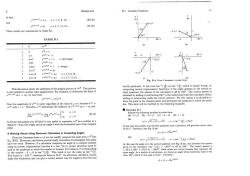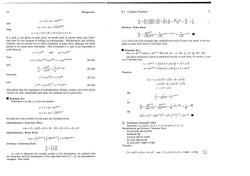《信号与系统》课程教学资源(书籍文献)信号处理与线性系统(英)B.P.Lathi, Signal Processing and Linear Systems

Sigmal Udy U2 Processing Lnear Systems ISBN0-941413-35-7 B.P. Lathi 621.372.54 LAT Berkelev- Cambridge

vi Preface Preface standard software package in an clectrical engineering curriculum. University),Prof.Mark Herro(University of Notre Dame),Hua Lee (Universi ny students are handicapped by an inadequate background in basic materia oids,sketching signals,Cramer's rule,partial and matrix algebra.I have added a chapter that addresses and pervasive topics in electrical engineering.Response by student nerous help with computer solution of several pro MAT 900 with erercises /with answers)for stu ng Ming Chang for his enthusiastic and crucia LAB problems and using computer to prepare the manuscript. uld like There are also about 400 selccted problems i in this er at the end of the chapters.Many problems are provided ntion the enormous but invisible sacrifices of my wife Rajani student in the proper direction. conti equentially,with B.P.Lathi 0. desired. 7.The summary at the end of eac pter prove up essential developments in the chapter,and tool in the stud MATLAB for tests.Answers to sel viding feedback to Throughout this book,examples have bo n provided to famillarize the reader 8.There are several historical notes to enhance stu dent' in the werful and versatile These facts introduce students to historical kgrou time and cos asociated with the analysis development of electrical engineering. and design of systems can b d b using computer software packages for Organization simulation.Many corpor ort the development systems math esults which suggest a design The book opens with a chapter titled Background without prot comp natical background material that a student taking this co course work.The already mastered.It includes topics such as complex ds the value of cmputer packages for systems design and simulation. signals,Cramer's rule,partial fraction expansion,m The MATLAB is the software package used throughout this book.MATLABis a ters deal with continuous-time signals an owerful package developed to perform matrix ma discrete-time signals and systems.I he MATLAB is easily expandable and uses its own There are MATLAB examples dispe the book can be r ead make developing sophisticated sys ddit MATLAB has boen It can also be used as ly tailored for a varety of courses a text for a first undergraduate couse in Digital sing (DSP) The organization of the book permitsgre deal ofx in teaching the student edition of the MATLAB when used aco continuous-time and discrete-time conce The natu rch path.MATLAB can be invoked by executing the comman nd MATLAB The meant for a sequential approach in which all the contim ered first,followed by discrete-time analysis. to i ate(in MATLAB banner will appear after a moment with the prompt MATLAB has It I weave)continuous-time and discrete-time analysis by usinga appropri seful on-line help.To get help on a specific comm HELP COMMAND P of chapters. MATLAB be us Credits to he written on the named file MATl io The phot p.380,F6 the 49 d for these files.Once familiar with the ba sics of MATLAB,t r can easily tution.The photographs of Cardano(p.3)and Gibbs(P .206)h e been reprinte learn how to write functions and to use MATLAB's exis courtesy of the Library of Congress.Most of the MATLAB example s were prep The MATLAB M-files have been created to suppleme all the examples solved by MATLAB in the text. These M-files may by Dr.O.P.Mandhana of IBM,Austin,TX. from the Mathworks anonymous FTP site at Acknowledgments ftp://ftp.mathworks.com/pub/books/lathi/ Several individuals have helped me in the preparation of this book.I arn grate ful for the helpful suggestions of the reviewers Professors.Dwight Day(Kansas State O.P.Mandhana

Contents Contents ix 25524 ldeal and Practical Fiters B Background Signal Energy mmunications:Amplitude Modulation B.1 Complex Numbers 1 Signals er's Rule 4924 9 Data Truncation:Window Functions 4.10 Summary Partial fraction expansion 5 Sampling 319 B 6 Vectors and Matrices 5.I The Sampling Theorem 319 B.7 Miscellaneous 5.2 Numerical Co of Fourier Transform:The Discrete 1 Introduction to Signals and Systems Fourier Transfo 5.3 The F ansform (FFT) 1.1 Size of a Signal 3 6 Continuous-Time System Analysis Using the Laplace Transform 361 Od Functions 16 Systems :579 Some Properties of the Laplace Trans 61 orm 1.7 Classification of Systems 390 6.3 System Model:Input-output Descriptior 6.A Summary 2 Time-Domain Analysis of Continuous-Time Systems 104 Introduction 104 The Bilateral Laplace Transform The Unit nse tonteral Canditions:Zero-input response 话139 6.9 Appendix 6.1:Second Canonica Realization 2.3 6.10 Summary 2.4 stem Re onse to External Input:Zero-State Response 气0 ifD浦eretia 7 Frequency Response and Analog Filters 471 25 System Stability The ulse Response 12131 stem design Using frequency Response by Placement of Poles and Zeros of H(s) 3 Signal Representation By Fourier Series 171 75 Butterworth Filters Chebyshev Filters n:Correlation atisfy Diste Hess Transmission Conditions Signal Re sentation by Orthogonal Signal Set 3.4 Trigonometric Fourier Sories 8 Discrete-Time Signals and Systems 540 3.5 Expon ential Fourier nerical Computatio ystem response Pe 82 Sampling Continuous-Time Sinusoids and Aliasing 45 3.93 8.4 Useful Signal Operations 4 Continuous-Time Signal Analysis:The Fourier Transform 235 Examples of Discrete-lime System 8.6 Summary 305 9 Time-Domain Analysis of Discrete-Time Systems 573 6 vi

Appendix 9.1:Determining Impulse Response 9.8 Summary 10 Fourier Analysis of Discrete-Time Signals 617 10.2 AperiodicS ion With the Continuous-Time Fourier transform Discrete-Time Linear System analysis by DTFT 10.6 Signal Processing Using DFT and FFT Background 10.7 Generalization of DTFT to the 2-Transform 10.8 Summary 11 Discrete-Time System Analysis Using the 2-Transform 668 The topics discussed in this chapter are not entirely new to students taking ave already studicd many of these topics in earlier courses or are 11.1 The 2-Transform of the 2- 68 this them from your previous training.Even so,this background m 12 es a review because it is so pervasive in the area of signals and systems Syste 115 Connection Between the Laplace and the 2-Transform 时oaae 11.6 Sampled-Data(Hybrid)Systems It will also be helpful as reference material in your future professional career. The Bilateral Z-Transform 1.8 Summary 710 B.1 Complex Numbers 12 Frequency Response and Digital Filters 716 an integral Pole-Z 5 part of the modern number system. imaginary ponse numbers,sometimes seem mysteriou 12.4 Filter Des ign Criteria 12.5 Recursive Filter Design:The Impulse Invariance Method 强 rives from their unfamilia "for the tern im- Recursive Filter Design:The Bilinear Transformation Method 740 mediately prejuc me other name,they wo ld have be just as irrational numbers or negative nu ers were.Ma physical meaning to im this effort is needless In moath we wish as loug as internal 13 State-Space Analysis 784 ch would have been to define a symbol operty i2=-1.The history of Introduction “imag ntitie 4f re for Determining State Equations enfamiliar and held in abborrence until 13.3 olution of State Equations ity m 13.4 Linear Transformation of State Vector historical 13.5 B.1-1 A Historical Note 189 Among early people the number system consisted only of natural umber Answers to Selected Problems (positive integers)neec h 843 arrows.These people had no ne and one-half Supplementary Reading children or three and one-fourth cows Index 844

2 Background B.1 Complex Numbers However,with the advent of agriculture, and so on.The number s ystem.therefore was extended to include fractions.The ancient Egyptians and Babylonians knew how to handle fractions,but Pythagoras discovered that some numbers (like the diagonal of a unit square)could not expressed as a whole number or a fraction.Pythago regarded numbers as the essence and principle of all things in the unive se.was so appalled at his discovery that he swore his followers to secrecy and imposed a death penalty for divulging this secret.!These numbers,however,were included in the number system by the time of Descartes,and they are now known as irrational numbers Until recently,negative numbers were not a part of the number system.The concept of negative numbers must have appeared absurd to early man.However, the mdievdcleareof theofp Ihey were also the nrst to recognize the existence of a ()ot onh The works of Bhaskar (1114-1185)on arithmetic (Lilaveti) cemn but also give rules for deal rs have two e and Gerolamo Cardano (left)and Karl Friedrich Gauss(right). imaginary numbers plausible and acceptable to early mathematicians.They could ducats A目th -1as pure nonsense when it appeared as a solution to to write the differ 2 stood at of a his no n154 on the ebit side again agna (The Grea!Ar aic wor pegative numbers.Theac ade it possible to solve In this ok tie gave a ng a genera ations such asr+5=0.which had no solution before.Yet for equations such as ,the in an intermediate step.According mpletely new kind of number theDuring the time of Deacarte Net 3+ar+bm0 (or compex)numbers came to be accepted as part of the number system,bu is given by they were still regarded as algebraic fiction.The Swiss mathematician Leonhard Euler introduced the notation i (for imaginary)around 1777 to represent v-1. -多+V度+器+-身-V厚+器 Electrical engineers use the notation j instead of i to avoid confusion with the notation i often used for electrical current.Thus 众心ond3ti0+6a-0=0eta-6-一 equation to obtain 2=-1 and 王=10+v108+10-108=20.392-0.392=2 =j We can readily verify that 2 is indeed a solution of 3+6r-20.=0.But when This notation allows us to determine the square root of any negative number.For Cardano tried to solve the equation-15x-4=0 by this formula,his solution example. V-4=A×-1=±2j When imaginary numbers are included in the number system,the resulting numbers are called complex numbers. Origins of Complex Numbers 之 ation with real roots that made

4 Background B.1 Complex Numbers x■2+12i+2-V-12 What was Cardano to make of this equation in the year 1545?In those days negative numbers were themselves suspect,and a square root of a negative number was doubly preposterous!Today we know that (2±)3■2±11=2±V-121 Therefore,Cardano's formula gives x=(2++2-)=4 Coupiry We ean readily verify thatr=4 is indeed a solution of -15x-4=0.Cardano tried to explain halfheartedly the presence of-121 but ultimately dismissed the whole enterprise as being "as subtle as it is useless." A generation later,bowever, Raphael Bombelli(1526-1573),after examining Cardano's resuts Fig.B.1 Use of complex numbers can reduce the work proposed ceptance of imaginary numbers asa vehicle tha spo mathematician from the real cubic equation to its real solu ords :=a+jb B.1) while we地ga end with real numbers,we scem co 6。 day,this The numbers a and b(the abscissa and the ordinate)of z are the real part and ly stra ge is the imaginary part,respectively,of :They are also expressed as he Re:=a lent in Still.Bomt elli des Im 2=6 h rale to 1799 ian Karl Friedrich Gauss.at a rip Note that in this planeal realnmbers eon the horizontaaxsnd almg of 22, the tal theore namely that every alg tical axis oot in the for of g complex number.He showed also be expressed in terms of polar coordinates.If(r) that ev of the ath order has exactly n solutions (roots),no more and no =+j(see Fig.B.2),then af the first to aiv a coherent account of complex numbers and to inte plex plane it is he who introducedi the ter com ved the way for eneral and systematic use of complex mbers.The number system was once again broadened or generalized to include b=rsin imaginary numbers.Ordinary for real)numbers became a special case of generalized and (or cor The utility of complex numbers can be understood readily by an anslogy with two neighboring countries X and Y,as illustrated in Fig.B.1.If we want to travel =r(cos 8+jsin 0) (B.2) from City a to City(both in Country X),the shortest route is through Country Y, although the journey begins and ends in Country X.We may,if we desire,perform this journey by an alternate route that lies exclsively in X,but this alternate route is longer,In mathematics we have a similar situation with real numbers (Country X)and complex numbers (Country Y).All real-world problems must start with rea numbers,and all the final results must also be in real numbers.But the derivatlon of results is considerably simplified by using complex numbers as an intermediary. It is also possible to solve all real-world problems by an alte rnate meth real numbers exclusively,but such procedure would increase theorkeedy. B.1-2 Algebra of Complex Numbers A complex number (a,5)or a+jb can be represented graphically by a point Fig.B.2 number in the cpex plane. whose Cartesian coordinates are (a,b)in a complex plane (Fig.B.2).Let us denote this complex number by so that

Background B.1 Complex Numbers The Euler formula states that cos 6+j sin 8 To prove the Euler formula,we expand and sin usingaMaclaurin series 9=1+0+++0+++. Re 5 =1+0-的的 2 31 6 Pig.B.3 useful identities in term 8=-+智-+. The graphical representation of a number s and its conjugate is depicted in Fig. B.2 Observe that ais a mirror image of about the horizontal axis.To find the Hence,it follows that ace8om的aej切-nthat b(dh 1=eos 6+j sin (B3) The sum of a complex number and its conjugate is a real number equal to twice the real part of the number: Using (B.3)in (B.2)yields :■a+市 ¥+”=(a+j)+(a-=2a=2Rez B,10 =refe (B4) The product of a complex number and its conjugate isa real number a complex number can be expressed in Cartesian form+or polar form the square of the magnitude of the number: z*=(a+)(a-j)=a2+2= (B.10b) a =rcos. bursin (B5) and Understanding Some Useful ldentities 。=m() aint at a distance r from the origin and r=√a2+2 (B.6 n in Fig.B.3a For example,the l is and has Observe that is the distance of the For this it dis ce from the origin as seen from Fig.B.3b.Therefore, an angle or(in fact. r is also calle时 1em=-1 In fact, =r, L:=8 e=-1 n odd integer (B.11 and :=leilr (B7) The number 1.on the other hand,isalsoata unit distance from the orign,bu Also has an angle 2(in fact,+2nm for any integral value of n).Therefore, 生=”=高 (8.12) (B8 e+2m=1 n intege时 The numberis at unit distance from the origin and its angle is/(se Fig.B.3b) Conjugate of a Complex Number Theretore, eltp2=j We define 'the conjugate of =a+jb,as Similarly, (B,9a) e2=-寸 *=a-fb=re Thus =lzle-J4: (B.96 e2=打 (B.13a)

8 Background B.1 Complex Numbers In fact enm/2=jn=1.5,9,13,: (B.13b) and 3 en2=jn=3.7,11.15, (B,13c) These results are summarized in Table B.1. 63 TABLE B.1 1 0 e0=1 1 士x em=-1 Re- Re 1 士升智 e封n=-1 n odd integer -1237 1 ±2m e2r。1 1 土2n 2nr=1 n integer 1 土x/2 e封/2=封 -3 emm/2-士封n=1,5,9,13 2-3 士nT/2 1 土nx/2 ew/2=干jn=3,7,11,15,. Pig.B.Pom are fourth quadrants.It will read tan-1()as tan(),which is clearly This disc ssion shov computing inverse trigonome g the answer of the 80 t answer is g180 ith the calculator ela+jult cat lt ting yields the ason it is advisable to 线he magnitude of csoe is anity regardi恶Eee ines the behavior of e()as too and ■Example B.l mea*g=▣ee= 0 a0 (a)2+3(b)-2+1(c)-2-3(d)1-3 In future discussions you will find it very useful to rememberas a number at a (a) 1l=V22+32=v3tg=tan'()=56,3 distancer from the origin and at an angle with the horizontal axis of the complex plane. .Therefore,(see Fig.B.4a) A Warning About Using Electronic Calculators in Computing Angles 2+8=e4.3 From the Cartesian f 6 l=V0-2p+=v5a=1()-153.4 if a omputes an angle of a complex number 6=tan-(b/a) oper attention must be t in wbich the number is located.For instance,corresponding 26 3 is tan-1(=3).This result is not the same as tan1() Ass matter of conveniece,we choose an angle whose numerical value is less ie -123.7° eas the latter is 56.3.An electronic caleulator cannot than18o°.which in this case153.d°,Therefore,. ake this distinction and can only for angles in the 2+=V5e4

10 Background B.1 Complex Numbers (e) -2 Re- =V-2驴+(-3那=v13 t=tan()=-123.7 answer obtained by B.4c) 2 -2-3V3e1路,m (d) 川-V+(仁3∬=o4a=tan-(学)=-71.6° (b answer given by the calculator (tan(=- 1-j3=04-1m8”■ Re umbers in polar focm:(a)2+j3 (b)-+1 MATLAB function pol(a,b)can be used to oovert the complex number 3。-3 to its polar form. -cart2pol(2,3) 2ag-3.6056 Zangle_in deg=Zanglein_rad*(180/pl) 2ang18.1nd0g56.31 Therefore ¥=2+3=3.6056e361 RE→ (b) 2e=2 [Zanglein_rad,Zmag]=cart2pol(-2,1) 242 (e) =Zangle in-rad*(180/pi) Fig.B.5 From polar to Cartesian form. g11ndg153.4349 ¥=-2+1=2,2361e1a.44 convt the compex mumber re to Cartean fo NMATLAD omaicalyt care of the quadramt in which the coplex uber ocart(-3/4.) 282 ■Example B.2 g-2.8284 Therefore 4e-f4=-28284-2.3284 (a)2e=(c0sjsin=1+(see Fig.B.5a) ⊙ (b)4e-04=4(os¥-jsin)-2Va-2W2(eFgB.b (c)2en/2=2(co6号+1n》=20+11)=2. Arithmetical Operations,Powers.and Roots of Complex Numbers (d)3c-r=3(o3x-i如3x)=3-1+f0)=-3 B.5d) (e)22=2(cos 4x jsin 4)(+j)=2 (see Fig:B. ()2e-r=2(eos4r-1n4x}=2(1-0)=2 (see Fig B.5f)■ Cartesian form.Thus,i

Background B.1 Complex Numbers 13 4=3+4m5e59,1 and 兽-=滑-+品82持 then 22+3=V1336.3° Division:Polar Form 1+9=(3+j4)+(2+j3)=5+7 3531# given in polar form,we would need to convert them into Carte sian form fo uh2nd vision, 山方wpn this example that multiplication and division however,can be or pola o n the latte plish in polar form than in Cartesian form. =r1c ■Example B.4 and =raejda For =2e/4 and za8e/find (m)2z-z (b)(e)(d) then (a)Since subtraction cannot be performed directly in plafor,we cerand 2=(r1e3)(r2e)=rnre9+8 (B.15a to Cartesian form: and n=2e"=2(c0e吾+fn)=v2+② (B.15b) a8e3=8(c0sjsi)=4+jv3 Therefore Moreover, =(reie)"=reine (B.15c) 2-扫=2v2+V2)-(4+4v③ and sin(rein=rimn (B.15d) =(2v2-4)+2v2-4v3 =-1.17-j41 This shows that the operations of multiplication.division,powers,and roots can be carried out with remarkable ease when the numbers are in polar form. 3 ■Example B.3 言=-心 21■3+34=5231 寻==动-动 2=2+j沿=V155a (d) =3=(8c/是=8时(e/=2ar%■ Weshall ove this problem in both por and Cartesanform Multiplication:Cartesian Form Computer Example CB.3 212=3+j40(2+3)=(6-12)+(8+=-6+j17 2a2+ Multiplication:Polar Form 1=8+j42=2+j*3 g1221*3 a-(6ea)(Besr)=5ve1oo z1z2-6.000+17.00001 sl_over_x2=21/22 Division:Cartesian Form z1.070rz2-1.3488-0.07691 Therefore In order to eliminate the complex number in the denominator,we multlply both (3+4)2+j3)=-6+178d3+f4/2+3)=1.3486-0.0789 ⊙ the numerator and the denominator of the right-hand slde by 2-f3,the denominator's conjugate.This yields
按次数下载不扣除下载券;
注册用户24小时内重复下载只扣除一次;
顺序:VIP每日次数-->可用次数-->下载券;
- 《信号与系统》课程教学资源(书籍文献)信号与系统 Signals & Systems(第二版,奥本海姆).pdf
- 《信号与系统》课程教学资源(书籍文献)信号与系统常见题解析及模拟题(西北工业大学出版社:范世贵).pdf
- 石河子大学:《信号与系统》课程授课教案(任课教师:查志华).doc
- 榆林学院:《数字电子技术基础》课程授课教案(讲义,任课教师:高燕).pdf
- 新疆大学:《数字信号处理》课程教学课件(PPT讲稿)第四章 无限长单位脉冲响应(IIR)滤波器设计 4.4 从模拟滤波器低通原型到各种数字滤波器的频率变换(原型变换)4.5 从低通数字滤波器到各种数字滤波器的频率变换(Z平面变换法).ppt
- 新疆大学:《数字信号处理》课程教学课件(PPT讲稿)第四章 无限长单位脉冲响应(IIR)滤波器设计 4.3 根据模拟滤波器设计IIR滤波器.ppt
- 新疆大学:《数字信号处理》课程教学课件(PPT讲稿)第四章 无限长单位脉冲响应(IIR)滤波器设计 4.2模拟低通滤波器设计.ppt
- 新疆大学:《数字信号处理》课程教学课件(PPT讲稿)第四章 无限长单位脉冲响应(IIR)滤波器设计 4.1 滤波器的基本原理.ppt
- 新疆大学:《数字信号处理》课程教学课件(PPT讲稿)第六章 数字信号处理系统的实现 6.1 数字滤波器的结构 6.2 量化与量化误差 6.3 有限字长运算对数字滤波器的影响 6.4 极限环振荡 6.5 系数量化对系数滤波器的影响.ppt
- 新疆大学:《数字信号处理》课程教学课件(PPT讲稿)第六章 数字信号处理系统的实现 6.6 数字信号处理硬件(数字信号处理器).ppt
- 新疆大学:《数字信号处理》课程教学课件(PPT讲稿)第五章 有限长单位脉冲响应(FIR)滤波器的设计方法.ppt
- 新疆大学:《数字信号处理》课程教学课件(PPT讲稿)第二章 信号的采样与重建.pptx
- 新疆大学:《数字信号处理》课程教学课件(PPT讲稿)第三章 离散傅里叶变换及其快速算法 3.3 快速傅立叶变换 3.4 关于FFT应用中的几个问题.ppt
- 新疆大学:《数字信号处理》课程教学课件(PPT讲稿)第三章 离散傅里叶变换及其快速算法 3.1 离散傅立叶变换 3.2 利用DFT进行连续信号的频谱分析.ppt
- 新疆大学:《数字信号处理》课程教学课件(PPT讲稿)部分分式.pptx
- 新疆大学:《数字信号处理》课程教学课件(PPT讲稿)第一章 离散时间信号与系统.pptx
- 新疆大学:《数字信号处理》课程教学课件(PPT讲稿)用留数定理求逆Z变换.pptx
- 新疆大学:《数字信号处理》课程教学课件(PPT讲稿)幂级数展开法(长除法).pptx
- 新疆大学:《数字信号处理》课程教学课件(PPT讲稿)绪论DSP.pptx
- 《数字信号处理》课程教学习题解答.pdf
- 《信号与系统》课程教学资源(MATLAB教程)第一章 MATLAB 入门.doc
- 《信号与系统》课程教学资源(MATLAB教程)第七章 MATLAB的GUI 程序设计.doc
- 《信号与系统》课程教学资源(MATLAB教程)第三章 MATLAB的数值计算功能.doc
- 《信号与系统》课程教学资源(MATLAB教程)第二章 MATLAB程序设计基础.doc
- 《信号与系统》课程教学资源(MATLAB教程)第五章 图形处理功能.doc
- 《信号与系统》课程教学资源(MATLAB教程)第六章 Simulink 基础.doc
- 《信号与系统》课程教学资源(MATLAB教程)第四章 符号数学基础.doc
- 《信号与系统》课程教学资源(实验指导)实验一 连续时间信号的MATLAB表示.pdf
- 《信号与系统》课程教学资源(实验指导)实验三 连续时间信号的卷积.pdf
- 《信号与系统》课程教学资源(实验指导)实验二 连续时间信号的运算.pdf
- 《信号与系统》课程教学资源(实验指导)实验五 周期信号的合成与分解.pdf
- 《信号与系统》课程教学资源(实验指导)实验六 傅里叶变换.pdf
- 《信号与系统》课程教学资源(实验指导)实验四 连续时间LTI系统的时域分析.pdf
- 《信号与系统》课程教学资源(实验指导)实验七 抽样定理.pdf
- 《信号与系统》课程教学资源(实验指导)实验九 离散时间信号的MATLAB表示.pdf
- 《信号与系统》课程教学资源(实验指导)实验八 连续时间LTI系统的复频域分析.pdf
- 《信号与系统》课程教学资源(实验指导)实验十 离散时间信号的运算.pdf
- 《信号与系统》课程教学资源(实验指导)实验十一 离散时间系统的响应.pdf
- 《信号与系统》课程教学资源(实验指导)附录二 MATLAB主要命令函数表.pdf
- 《信号与系统》课程教学资源(实验指导)实验十三 综合设计-无失真传输系统.pdf
